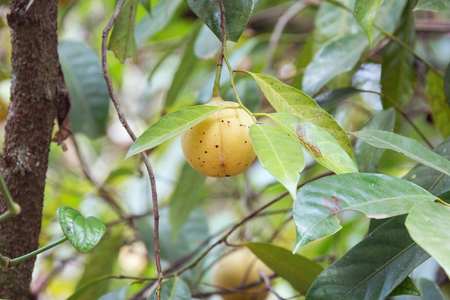Nutmeg - Myristica fragrans

Common Names: Nutmeg, Nutmeg tree, Myristica, Mace, Myristica fragrans, Muscadier (French), Muskatnuss, Muskatbaum (German), Noix de Muscade (French), Nuez Moscada (Spanish), Muscade et macis, Macis, Jayapatri, Javitri, Jatipatri, Jatikosha, Jaiphal, Jaatipatree, Jatiphalam, Ron Dau Kou, Muskat, Macizeň, True Macizeň, True Nutmeg
Latin Name: Myristica fragrans
Origin: Asia, South America
Short Introduction
The natural environment for optimal growth of Nutmeg is the humid tropics, with average annual rainfall between 1,500 and 2,500 mm and a year-round average temperature above 26°C (night temperatures should remain above 10°C). The site should be well-drained, in sufficiently permeable soil. Harvesting of ripe Nutmeg fruits takes place throughout the year. The fruits are knocked down, the aril is separated from the nut, and everything is sun-dried. The dried aril (mace) is usually ground into powder.
Detailed Description
The exotic nutmeg tree, once valued as highly as pure gold.
Botanical Information
Nutmeg is a medium-sized, delicate evergreen tree reaching heights between 5 and 13 meters, though there are records of nutmeg trees as tall as 20 meters. The entire plant is gently aromatic. Nutmeg trees are dioecious, meaning male and female flowers appear on separate trees, although occasionally both flower types may be found on a single tree. The flowers are unisexual, bell-shaped, pale yellow, slightly waxy-scented, and arranged in clusters of one to three. The dark green, leathery, oval or lance-shaped leaves measure 5–15 cm in length and 2–7 cm in width, with smooth edges and are alternately positioned on the branches with about a 1 cm petiole. The fruit is spherical or pear-shaped, about 3–5 cm across, greenish at first and ripening to golden-brown, containing a seed. The seed has a hard outer covering, beneath which is a netted, marbled endosperm on cross-section—this is the actual nutmeg.
Origin and Distribution
Nutmeg grows most commonly in humid tropical regions where annual rainfall averages around 2,550 mm and the average temperature stays above 26°C year-round. It is most widespread in Southeast Asia, especially in the Chinese provinces of Guangdong and Yunnan, as well as Taiwan, Indonesia, Malaysia, the Caribbean islands, India, Sri Lanka, and South America. Originally, Nutmeg hails from the Moluccas in the Banda Islands of eastern Indonesia. Later, the plant was introduced to plantations in other tropical regions such as Sri Lanka, the Seychelles, the Antilles, Malaysia, and elsewhere.
Usage / Dosage
Nutmeg was first mentioned in Europe as early as the 11th century thanks to Arab traders and suppliers. It quickly gained great popularity and became widely traded; by the 13th century, nutmeg was prominently used in preparing delicacies and beer. The largest trade boom occurred in the 16th century, when Portuguese ships reached what is today India, nutmeg's "homeland." In the ensuing decades, the spread, cultivation, and commerce of nutmeg flourished thanks to Portuguese and Dutch traders. During this period, the Dutch East India Company earned great prestige and substantial profits from nutmeg.
Nutmeg has been a treasured and commonly used spice since ancient times, used in a wide variety of dishes, soups, vegetables, salads, sausages, baked goods, sweets, fish, condiments, and as an ingredient in alcoholic beverages (liqueurs, beer, etc.). It remains extremely popular in Indian cuisine (garam masala), as well as in Morocco, Tunisia, and Saudi Arabia. Essential oils are extracted from nutmeg and widely used in the cosmetics industry, especially as an ingredient in specialty soaps, perfumes, hair products, and mouthwashes.
Many scientific studies have described the effects of compounds from different parts of the Nutmeg plant in treating or supporting treatment of digestive tract disorders. The most commonly cited benefit is the effect (mainly of the essential oil) on healthy digestion and in treating related diseases. These compounds appear to stimulate appetite and relieve loss of appetite. The scientific literature has validated Nutmeg's effects in supporting normal digestive function and improving appetite.
Another potential indication for nutmeg relates to the use of its compounds for pain relief and inflammatory processes in the musculoskeletal system, particularly muscles and joints. The essential oils found in Nutmeg have shown benefits in easing joint and muscle inflammation. These essential oils are assessed as substances supporting the normal state of muscles and joints.
Traditional Uses
Folk medicine and traditional therapeutic uses highlight Nutmeg’s role as a spice. Folk remedies recommend Nutmeg for its bactericidal and aphrodisiac effects, as well as for supporting digestion, improving appetite, treating diarrhea, relieving flatulence, stomach complaints, kidney disorders, and preventing vomiting. Both parts of the Nutmeg tree—the aril (mace) and the seed (nutmeg)—are recommended for loss of appetite, digestive difficulties, and digestive tract cramps. Externally, Nutmeg is applied for rheumatic pain and for local treatment of inflammatory disease and pain.
Active Compounds
Nutmeg contains a large amount of essential oils (5–10%), as well as fats, steroids, lignans, and polysaccharides (starch). The essential oil contains monoterpenes including terpinen-4-ol, alpha-terpineol, dimethoxyphenol, eugenol, methylisoeugenol, methyleugenol, sabinene, terpineol, elemicin, pinene, camphene, p-cymene, myristicin, safrole, phellandrene, limonene, myrcene, terpenoid derivatives (linalool, geraniol, and terpineol), and phenylpropanes.
Traditional Dosage
The nut is most commonly used internally in powdered form. It is dosed in pinches (using the tip of a knife or spoon) and taken 3 times daily. About 1.5 grams of powdered nutmeg can be combined with cinnamon, ginger, star anise, or other spices to make a decoction. This decoction can also be used externally for rheumatic pain or toothache, by gently massaging into the affected area. The plant drug may also be incorporated into various (including commercially available) ointments or ointment bases.
